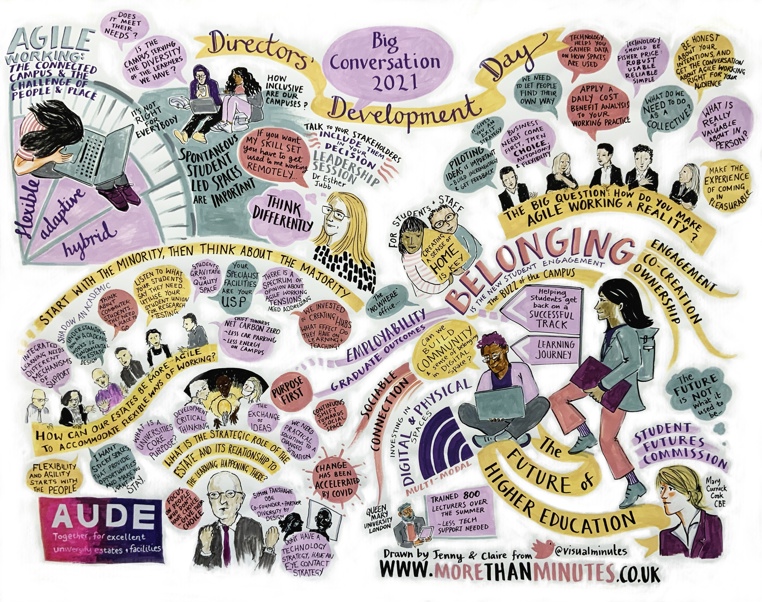
Published date: 26 October 2021
What's next for Smarter Working?
Kate Richardson, our Head of National Office Programme, shares some learnings from recent industry conferences on Smarter Working.
Author
This month I have joined a few industry events on the topic of smarter working, taking part in panels at Property Week’s WorkSpace conference and a ‘Big Conversation’ event with the Association of University Directors of Estates. The conversations focussed on our transition from reactive pandemic management to offering colleagues long term flexibility, but the wider events included sessions covering everything from recreating workplace culture to the changing property investment landscape, to people-first places prioritising wellness. Here are some of my key takeaways.

Illustrative summary of the AUDE 'Big Conversation' panel discussion
The Covid-19 pandemic catalysed a pre-existing trend
Smarter working is nothing new and builds upon decades of structural change in how we work and live. But it feels like the penny has now fully dropped, and change is accelerating at a pace we couldn’t have predicted pre-pandemic. Jeremy Myerson, Director of the Worktech Academy told us that flexible office space was at 5% of the UK serviced office market pre pandemic, but by 2023 it could be 20%. This may be less relevant to the NHSPS application, but still indicates a significant shift in demand and subsequent market change.
Now that change is accelerating, employers need to adapt now to remain competitive
With ‘The Great Resignation’ looming, companies need to adapt to survive, and listen to what their employees and applicants want. With only 12% of us wanting to come back to the office 5 days a week, organisations need to offer flexible working as standard in order to attract and retain talent. At NHS Property Services I have seen the added benefit of national hiring, which opens us up to a wider pool of talent than ever before, enable more diverse teams, and supports the governments’ levelling up agenda. I am also hearing great success stories where we have retained our talented people when they have chosen to relocate to be closer to family.
The office isn’t ‘dead’, and physical space remains important for most organisations
As Earle Arney, Chief Executive of AFK put it: “As knowledge workers we can do virtually everything, functionally, working from home. But the seed of creativity and innovation is really planted when people are the same space”. The physical space of an office remains an investment to attract, develop and retain talent, creating opportunities for informal and accidental learning and interaction. This is particularly important for those new to the workforce, or those ‘divergent’ meetings, as described by Bruce Daisley, ex Twitter VP, that are more challenging by nature and require face to face interaction to read micro signals in body language. Whereas for more standardised, ‘convergent’ meetings, remote working still works well without the need for extra travel.
Employers need to ‘sell’ offices to colleagues, giving them a reason to come and stay
The privacy and comfort of home working is hard to beat, and even top-rated offices are now struggling to compete. Mark Ferguson from Aura Futures compared this challenge to retail, and suggested we treat colleagues like customers when designing offices, considering their end to end experience of the space and how we can optimise it. This will mean catering to different demographics within your workforce, i.e., a more junior colleague may have less use for high quality AV to support customer meetings, but value spaces to socialise and collaborate, whereas a senior manager will be seeking a frictionless technology experience to make hybrid working seamless.
Good office design will recognise and embrace sustainability and wellbeing
Environmentally conscious design was top of mind throughout the day, with many property owners and investors noting an increased interest from occupiers in creating spaces that are sustainable as well as agile, inspiring, etc. This can go hand in hand with creating spaces that support colleague wellbeing and productivity, and reference was made to a study that found 26% higher cognitive and 8% higher sleep scores from those using buildings certified with BREEAM Excellence.
Developing ‘people-first’ places will unsurprisingly help organisations encourage colleagues back to the office in some capacity, and design principles considering colour, biophilia, and art were all discussed. Simple design solutions can be incorporated into existing offices too, such as lights on desks for colleagues to change the colour of to indicate if busy, focussed, or free.
Whatever comes next, flexibility is the foundation for future office design
Despite all the experts in the room, it is of course impossible to accurately predict future trends and needs for office space and working culture. What we do know is the importance of flexibility in the office estate, and more importantly, the organisational culture, to allow for future evolution. Those ‘getting it right’ might surprise you, with Bruce Daisley, ex Twitter VP, sharing that he’s seeing local councils becoming more dynamic than those who might traditionally be expected to do well, i.e., ‘Big Tech’ firms. The competition is on, and for all organisations the coming months and years will be crucial for embedding true smarter working for their colleagues.
Learn more about smarter working for the NHS
We have a huge opportunity to create better working environments for NHS staff, and to boost productivity and wellbeing via enabling smarter working and collaboration. There is also a significant potential to drive efficiencies and system savings, and create a more sustainable estate for the NHS through proactive management of the office estate.





